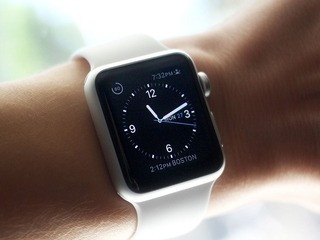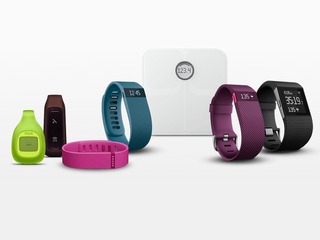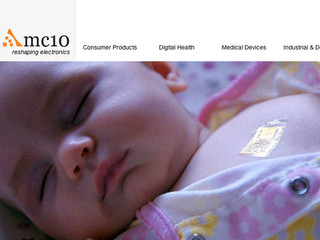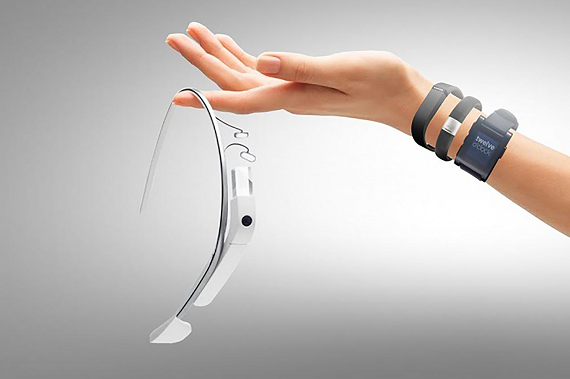
After years of aniticipation, 2015 really became the year of the wearable. We’ve already seen an explosion in popularity on the sales end and, by next year, one of our every four adults in the United States will have at least one wearable. That’s kind of amazing.
Not surprisingly, this trend has revved up activity on the other side of the spectrum: venture capitalists have seen those numbers and they are throwing money at wearable startups. According to data out from CB Insights, there has already been $1.3 billion invested in consumer electronics companies this year.
That is more than double the $680 million that was invested in 2014. Not only that, but it’s the first time in at least five years that more than $1 billion has been invested. The space came close in 2012 and 2013, but couldn’t get over the hurdle.
Still, consumer electronics has certainly come a very long way since 2010, when a mere $273 million was invested.
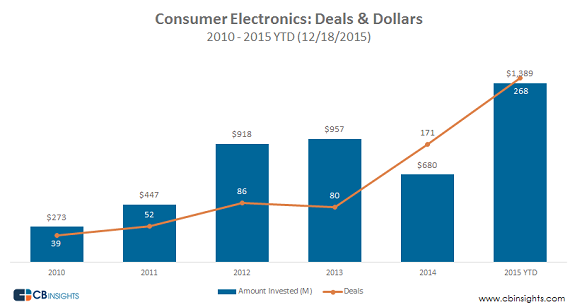
The space has also seen deals shoot up over the last couple of years, more than doubling in 2014, and now seeing a 57 percent increase, to 268 deals, in 2015. Here’s something really astounding: there were been more consumer electronics deals in 2015 than in the four years between 2010 and 2013 combined, 257 to 268.
The most exciting thing about this is that not only are more companies getting funded, but they are new companies, meaning that the entire space is being given a shot in the arm. Over the last three years the percent of consumer electronics companies getting angel and stage deals has been around 44 percent, up from just 24 percent in 2011.
That is not to say that there aren’t a huge number of mature companies in the space that have been waiting for their moment as well. 2015 also had the largest number of exits in the consumer electronics space in 2015, with 41.
That includes Fitbit, which went public in June at a valuation of $4.1 billion, making it the largest weable exit of all time.
There have been only other two companies to exit in that range in recent years have been GoPro and Oculus.
High definition camera manufactuerer GoPro had an IPO of its own in 2014, exiting at a valuation of $3.1 billion; the company is now selling at $58.28 a share, almost two and half times it’s $24 IPO price. FitBit’s IPO was 32% larger than GoPro‘s.
Immersive virtual reality technology company Oculus, on the other hand, exited when it was bought by Facebook in March of last year for $2 billion.
After that, the numbers fall sharply. Smart eyewear company Recon was bought by Intel on Wednesday for $175 million, while Intel also bought Basis, maker of the popular wristwatch health tracker, for $100 million in 2014.
Rounding out the top five deals, BodyMedia, the developer of on-body monitoring systems that collect physiological data to improve health, wellness and fitness, was purchased by Jawbone in 2013.
While “there have not been many large exits in the space,” CB Insights wrote, with less than 30 companies exiting for over $100 million since 2010, “as wearables and more IoT products increase in popularity, we can expect to see more exits happening in the future.”
This is a really exciting time for this space, as newer companies are finding it easier to get funding, the old dogs are now in place where they can see big exits.
Wearables
While CB Insights chalks this ramp up, in part to, “sensor and electronic part costs falling,” the real impitus has been the rise in wearables.
With the oncoming launch of the Apple Watch, there have been expectations that this would be a breakout year for wearables. A report earlier this year forecasted that the number of wearables shipped would more than double in 2015 to 45.7 million units, up from 19.6 million in 2014.
By 2019, total shipment volumes are forecast to reach 126.1 million units. That means it will have a five-year compound annual growth rate of 45.1%.
Those predictions turned out to be correct. In all, 39.5 million adults in the United States will use at least one wearable, including a smartwatch or a fitness tracker, this year, according to eMarketer. That will be an increase of 57.7% over the 25. 1 million who used them in 2014.
And those numbers are going to explode after that. In 2016, there are expected to be 63.7 million wearable users, or nearly 30% of Internet users and 25 percent of all adults in the United States. Though the growth is expected to taper off, by 2018, it will be 36.5 percent, which will include 81.7 million users. By 2019, almost two in five internet users will use wearables, and almost 40 percent of Internet users.
That means that over a third of all U.S. adults will either wear accessories or clothing at least once per month that have Internet-connected electronics and exchange data with a manufacturer.
Those are some spectaular numbers, and venture capitalists would be foolish not to try to jump on that bandwagon.
(Image source: blog.xhackers.co)

















